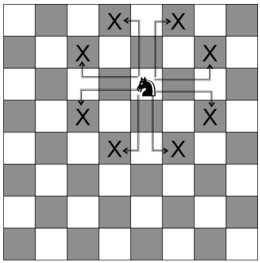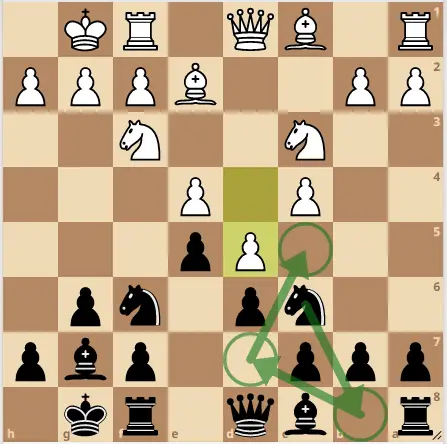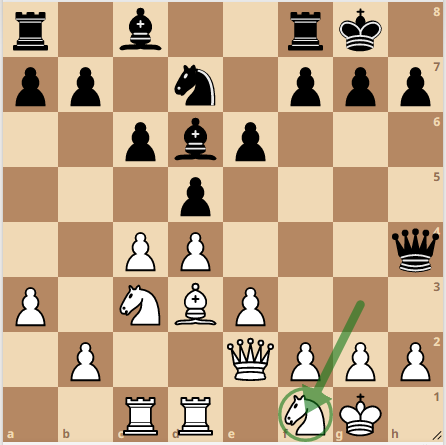The knight is a very tricky piece as it pounces about on the chess board in the most unusual way. For many beginners just learning the game of chess, the movement of the knight is one of the most challenging aspects to grasp in chess. But I assure you, by the end of this article, you’ll learn how to master it in no time.
Let’s take a look.
Can A Knight Move Backwards In Chess?
Yes, the knight can move 2 squares backwards like a rook and then one square at a right angle. This forms what is known as an L-shape.
In chess, you should avoid moving your knights backward unless you have a clear objective strategy in mind. This strategy could include rerouting the knight to a more active square, or moving the knight backwards to play defensive duties.
Knight moves in a L-SHAPE (forward or backward)

This strategy usually works well in closed positions as time is not much of a factor. However, In open positions, you want to abstain from moving your knight backwards. The goal should be to develop your pieces onto their most active and natural squares. If your knights are passive, they won’t be able to participate in the game.
In the position below, it is okay for the black knight to move backwards onto its initial square. He can afford to use the time to reroute his knight to a better square since the position is closed. The ideal square for the knight is c5. He can get there via Nb8-d7-c5.
King’s Indian Defense: Knight can move backwards to b8 as shown by the green arrow

The knight can also move backwards to the e7 square. This is actually the mainline of the King’s Indian defense, but Nb8 has also been growing in popularity.
Why You Shouldn’t Move Your Knight Backwards?
Knights become more powerful as they advance up the board to higher ranks. A knight on the 5th rank for white is more powerful than a knight on the 1st rank for white. Simply because the knight on the 5th rank controls more squares in the center than the knight on the edge of the board.
Therefore, you should always strive to move your knights forward up the board into your opponent’s territory rather than moving them backwards.
A knight becomes less powerful when you move it backwards as more squares are taken away. A knight that is placed on the edge of the board or on the backrank can only control 4 squares at max or 2 squares in the corner of the board. However, a knight in the center of the board can control up to 8 squares and has better attacking chances.
Knight is more active in the center than on the backranks

For this reason, you should be careful when moving your knight backwards unless you have a strategic plan in mind. Let’s look at a few of these strategic examples.
The Strategic Knight
The knight is the best piece for carrying out a strategic plan in the chess game. There are several strategic moves you can make with the knight. This include:
- Using the knight to blockade passed pawns
- Using the knight to attack weak squares
- Bringing the knight to an active outpost.
- Using the knight to defend the king
Using The Knight To Blockade Passed Pawns
The knight is the best piece for blockading passed pawns. A blockade in chess is when you use one of your pieces to stop your opponent’s piece from advancing down the board. For example, if your opponent has a passed pawn, then you should use your knight to blockade the pawn from advancing. This will prevent the pawn from promoting into a queen.
In most cases, the knight would have to travel backwards in order to create the blockade for the pawn.
The black knight on d7 is doing a good job blockading the white pawn on e6.

All in all, if you opponent has a passed pawn, you should find a path for your knight so that it can blockade the pawn from promoting. That could mean moving your knight backwards to get to the pawn in time.
Knight As Defensive Piece
A knight that is doing defensive duties is a useful piece rather than a passive piece. They are one of the best pieces for defending the kingside due to their flexibility. In the position below, the knight just moved backwards from g3 to f1. Here, the knight gives firm support to the h2 square and prevents black from checkmating the white king via Qxh2.
The knight move backwards to f1 to defend the h2 pawn.

Knight on the 1st rank can be helpful in defending squares around the king. It’s important to note that the knight on f1 is a better defender than the knight on f3. This is because the knight on f1 cannot be easily removed or captured by the opposing side since it is on the backrank behind the other pieces. A knight on f3 that is guarding the f2 square can be attacked or removed by one of black’s pieces, usually by a bishop.
Using The Knight To Attack Weak Squares
Unlike the bishop, the knight can attack weak squares, whether it be the light or dark squares. A bishop is always stuck on its colored square for the entire match. This means a bishop on the dark squares can never switch over to light squares. It’s almost like it’s stuck in another dimension.
Knights however, can move to both light and dark squares making them excellent attackers of any weak squares on the chessboard. With the right manoeuvring, the knight can get to any square it desires. The downside is that it would sometimes take a lot of time to get to that desired square, unlike the bishop that can swiftly move across one end of the board to the other.
Bringing The Knight To An Active Outpost
An outpost is a square for a piece that cannot be attacked by an opposing pawn. This square is on the fifth, sixth, or seventh rank and is protected by a pawn.
A knight on an outpost is sometimes more powerful than a rook, especially if it cannot be removed by a piece equal or lower than its value. In some cases, your opponent would have to sacrifice his rook just to remove the knight from its powerful outpost.
So how do you get a knight to an outpost?
Well, you have to first time it correctly. Just because you see a square for the knight doesn’t mean you should immediately move the knight there.
First, you should map out a path that the knight would have to travel in order to reach the square. This path could involve moving the knight backwards so that it can successfully reach the outpost.
Another important strategy is to get rid of any minor piece that could potentially remove the knight from its outpost. This would make the outpost even more powerful because the knight would be untouched.
The knight makes an oupost on f6. The knight is untouchable.

Final Verdict
Understanding how the pieces move is critical if you want to play chess well. The knight can move backwards in a chess game, but you should abstain from doing this, unless you have a valid reason. You should always think of ways in advancing the knight up the board. Knights on the 5th, 6th, 7th, and even 8th rank are more powerful because they control more squares in your opponent’s half of the board. This leads to better attacking chances.


